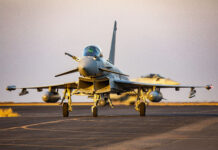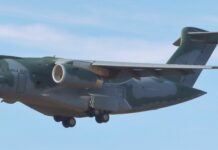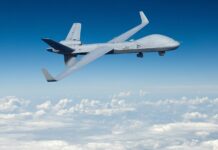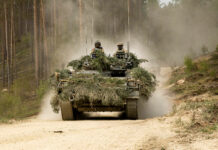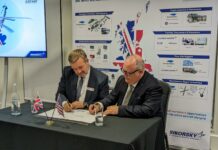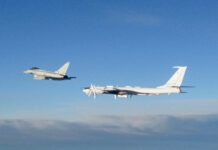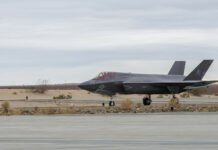BAE Systems announced at London’s DSEI exhibition on 13 September 2023 that its has received a GBP 40 M (EUR 46.55 M) contract to develop its Striker II next-generation helmet-mounted display (HMD) for the Royal Air Force’s (RAF’s) Typhoon fighter fleet.
The contract will see the Striker II reach substantial maturity and be fully integrated with the RAF Typhoon fleet in the latter half of this decade.
While the current-generation Striker I helmet is substantially an analogue system, the Striker II is fully digital, allowing colour symbology in the display instead of a purely monochrome green. Perhaps the most significant feature of the Striker II HMD, however, is that a night vision camera has been fully integrated into it, replacing the requirement for night-vision goggles (NVGs) to be attached to the front of the helmet. This allows a night vision image to be projected onto the visor, which is seamlessly blended with the flight reference symbology.
Andrew Mallory-Blythe, the Typhoon operational requirements manager within BAE Systems’ Air Sector, noted at DSEI 2023 that the Striker II HMD is now at the point where it can meet “what is almost certainly the most stringent list of operational requirements of any helmet in service in the world today”.
Speaking to an audience at the exhibition, Mallory-Blythe highlighted the key advantages brought to the pilot by the Striker II HMD.
“The first thing that it does is it allows the aircraft system to queue your eyes onto something.” This, he said, will “almost double the range that I’ll detect that target. And that will give me double the time to decide what to do about it.
“The next capability is that I can cue either a weapon or one of the aircraft’s many sensors onto something that I can see,” he explained. “Again, that will save a huge amount of time. If I see something I can press a hands on throttle and stick (HOTAS) button in the cockpit and immediately cue a sensor or a weapon; I can save time … which can be a significant tactical advantage.
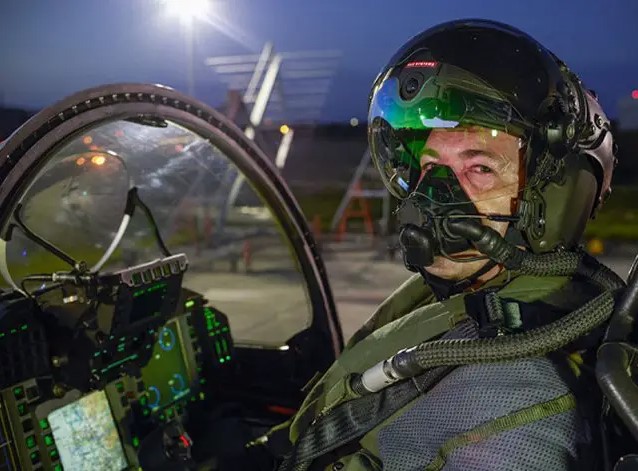
“The third area where this particular capability can really help me is the flight reference information,” said Mallory-Blythe. “As a pilot, I need to apply the aircraft to the parameters where it performs best within an engaging, demanding, tactical within-visual-range situation, so if I can look at the target, which might well be over my shoulder, and I can see my altitude and speed without having to go ‘heads in’ and reference the head-up display or other flight instruments, again, not only can I save time, but I can make sure that I don’t take my eyes off of a target or whatever entity it is that I’m looking at.”
Finally, Mallory-Blythe noted the significant improvements the Striker II HMD brings in terms of overall situation awareness. “What the helmet does through the tactical symbology,” he said, “is it augments the three-dimensional real world with that image using the same type of displays as are represented on the two-dimensional displays in the cockpit, so I can look at the two-dimensional displays and I can immediately reference the real world and see the same tactical information. So I’m using the real world as an extra display, and that is painting a picture for me in three dimensions – and that gives me significantly better situation awareness than if I was solely referencing the two-dimensional displays. And all of those capabilities are available now with the combination of the night vision image and the day tactical symbology in this helmet day and at night.”
Mallory-Blythe said that, “of those, situational awareness is probably the most important because, if you’ve got better situational awareness in cockpit than your adversary, you can make faster decisions than your adversary. If you can make faster decisions, you have the tactical advantage and you will stay ahead.”
BAE executives associated with the programme told ESD that, while the Striker II helmet will be just over 2 kg heavier than the current-generation Striker I HMD, this will still be lighter than a Striker I helmet plus its NVG fit. Mallory-Blythe additionally noted that the Striker II has “significantly improved the centre-of-gravity situation over NVGs” and that centre of gravity “is slightly more important than the overall mass of the helmet”.
In terms of what the Striker II contract means at a defence-industrial level, BAE Systems has stated that it will create and sustain more than 200 highly skilled jobs at its sites in Kent and Lancashire in direct relation to the programme.
Peter Felstead




